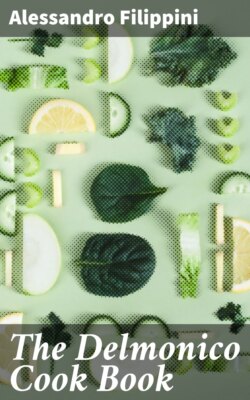Читать книгу The Delmonico Cook Book - Alessandro Filippini - Страница 7
JANUARY.
ОглавлениеLive codfish [Gadus morrhua]. Haddock [Melamogramus agle finus]. Cusk [Brosmius brosme]; this belongs to the cod family, and although very little known, is an excellent table fish. Hake [Phycis chuss]; this is another of the codfish family, but inferior to any of the other varieties. Halibut [Hypoglossus vulgaris]. Small chicken halibut [Hypoglossus vulgaris]. Striped bass [Roccus lineatus]. Eels [Arguilla vulgaris]. Lobsters [Homarus Americanus]; very scarce, and in poor condition. Fresh salmon [Oncorhynchus chouicha]; these salmon are caught in the Columbia River, Oregon, all the year round, and are shipped in refrigerator-cars, and received daily in the New York markets. Frozen salmon [Salmo salar]; caught in the Restigouche River in July, and kept in freezers. Turbot [Platysomatichthys hippoglossoides], coming from Newfoundland, are occasionally in market during this month. Frost-fish, sometimes called tom-cods [Microgdus tomcod]. Frozen fresh mackerel [Scomber scombrus]. Frozen Spanish-mackerel [Scomber omarus]. Pompano [Trachynotus carolinus]; a few occasionally in market, coming from Pensacola, Florida. Red-fish, or channel bass [Sciœna ocellata], caught in Florida. Sheep’s-head [Diplodus pobatocephalus], from Florida. Grouper [Epinephelus morio], from Pensacola; a very good fish for boiling, somewhat like the red-snapper, but the meat is of a finer grain. Red-snapper [Lutjanus Blackfordii] has become a staple article in our markets during the winter. They weigh from two pounds upward, as much as twenty pounds each. It is good either boiled or baked, but most epicures prefer it baked. In selecting a fish, care should be taken not to buy one that weighs over eight pounds, as anything larger than that is apt to be tough and lacking in flavor. Shad [Clupea sopidisima], caught in the St. John’s River, in Florida, are to be had nearly every day during this month. Frozen bluefish [Pomatomus saltatrix], preserved by being kept in freezers since the previous fall. Herring [Clupea harengus], from Nova Scotia. Skate, or ray-fish [Plerroplatea maclura]. The demand for this fish increases every year. The American people begin to appreciate its many excellences. Probably the annual dinners of the Ichthyophagous Club, at which this fish is always served, have materially increased the popularity and demand for this fish. Rainbow trout [Salmo irridea]. These fish were first marketed during the winter of 1885 and 1886, and they are one of the notable examples of fish-culture, as the following brief history will show. Six years ago Professor Spencer F. Baird, then Commissioner of Fish and Fisheries for the United States, received a lot of eggs of the rainbow trout from California. He presented five hundred of them to the South Side Club, who have one of the most complete fish-cultural establishments in this State. These eggs were hatched and the fish raised in the preserves of the Club, where they increased to such an extent that the Club decided to send their surplus to market, and they have become very popular, and sell readily at one dollar and twenty-five cents per pound. The open season for these trout is from April to September. Salmon-trout, frozen [Salvelinus namaycush]. Whitefish, frozen [Coregonus clupeiformis]. Pickerel [Esox reticulatus], weighing from half a pound to ten pounds each, are very good during the winter months. Wall-eyed pike [Sticostedium vitreum]. Catfish [Ictalurus punctatus]. Smelts [Osmerus mordax] are received from different parts of the East and North during this month. The choicest come from Maine and Massachusetts. Those coming from Canada are always frozen, and are inferior, and sold at a very low price. Green turtle. Diamond-back terrapin. Prawns, from South Carolina. Scallops. Oysters. The following are the best in this month: Blue Points, Shrewsburys, East Rivers, and Mill Ponds. Hard crabs. Crab-meat, fresh picked. Whitebait. Finnan haddie. Smoked salmon. Smoked halibut. Best boneless dried codfish.
